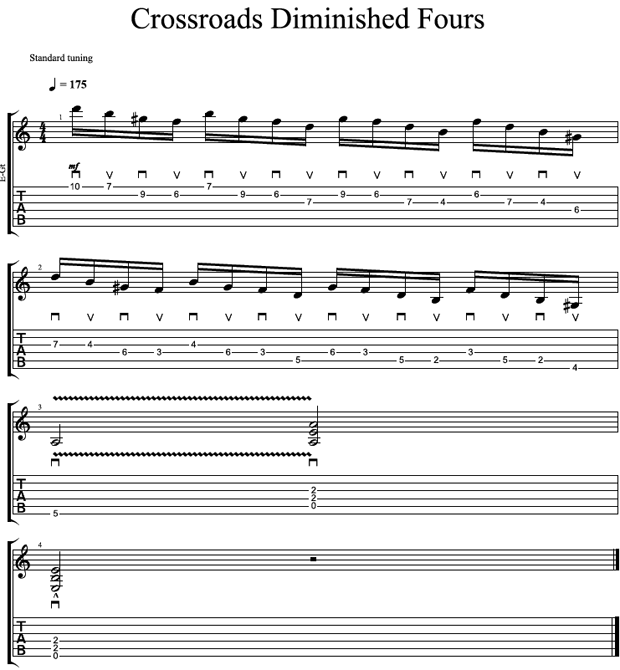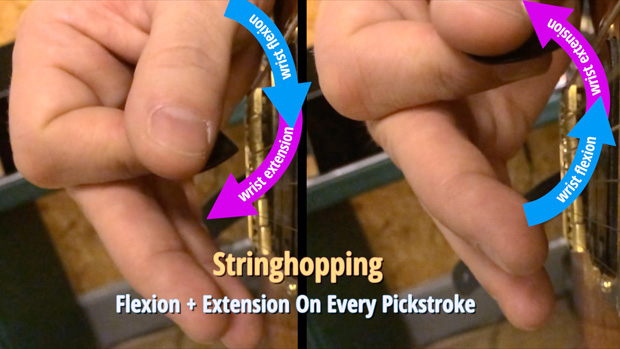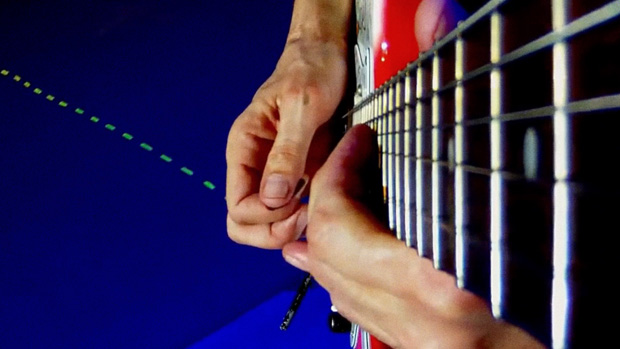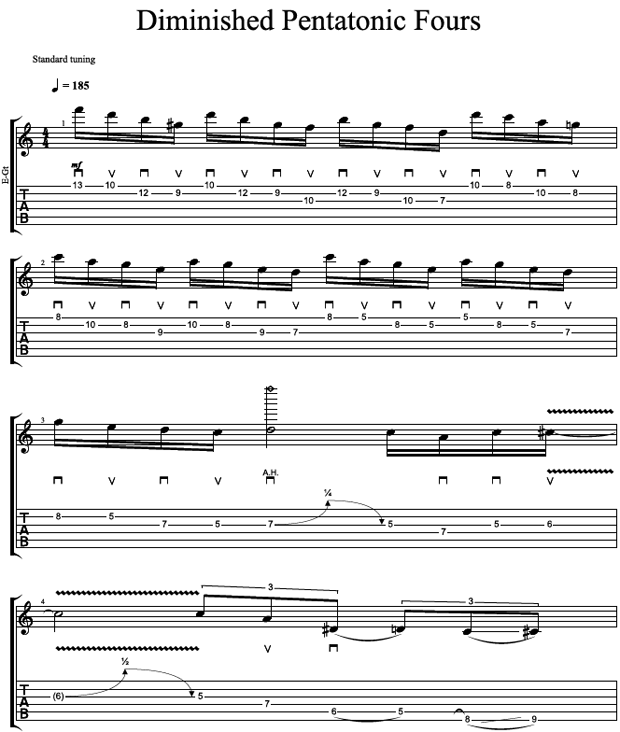Diminishing the Devil: Steve Vai's 'Crossroads' Fours
A comprehensive breakdown of Steve Vai's incredible descending diminished fours lick from 'Crossroads.'

The Eighties was a decade of unrivaled guitar heroism. And one of its greatest heroes is also one of its greatest villains.
Steve Vai's nefarious turn in the 1986 film Crossroads sent legions of kids scurrying to their metronomes in hot pursuit of his blistering neoclassical chops.
In fact, for many of us, Vai's incredible playing in Crossroads was our introduction to the neoclassical style.
Perhaps most influential of all was the Crossroads TV commercial, which ran with near ubiquity in the spring of 1986. And it contained a nugget of Vai's unforgettable guitar movie magic that practically leapt from the screens and demanded our attention. Of course, it's the famous descending diminished fours lick:
Crossroads Fours
When it came to marketing to teenage guitarists, the Crossroads producers knew what they were doing. They took Vai's incredible descending diminished fours lick and placed it prominently in the Crossroads TV commercial, just before the title card. This glittering cascading sequence, built from overlapping dominant seventh arpeggios, succinctly captured the essence of the solo's neoclassical inspiration as well as its impossibly precise execution. And it immediately had me begging my parents for movie tickets. Nowadays, Yngwie Malmsteen's swept arpeggio techniques are the de facto standard for infusing rock leads with diminished sonics.
But one of the many amazing characteristics of Vai's unforgettable Crossroads fours pattern is that it was entirely alternate picked:
All the latest guitar news, interviews, lessons, reviews, deals and more, direct to your inbox!

- This one lick was responsible for convincing an entire generation of players that classical music contained the key to plectrum precision. And it was also this same lick that, months of fruitless practice later, was probably responsible for dashing those hopes. And it turns out, there was good reason for it.
Stringhopping
Attempting to play this pattern with strict alternate picking very often results in a jumble of jumpy hand movements. In Cracking the Code, we call these kind of inefficient movements "stringhopping":
This repeated lifting and dropping of the pick is the bane of smooth alternate picking, and it's a feeling many players will find familiar. What's less obvious is why. Stringhopping is actually a specific picking technique that most players learn unconsciously when attempting to decipher complicated picking patterns. It's most often accomplished through wrist flexion and extension. Each flexion of the wrist drops the pick into the strings, and each extension lifts it back out.
Flexion and extension are the same movements you make when knocking on a door. Flexion produces the knock, and extension moves the hand back to the starting position so you can knock again. The trouble with this is that each knock requires two movements: one down and one up. And yet only one of them—the down—produces any sound. So when you use stringhopping as your picking motion, you're actually making twice as many hand movements as you need, and you're cutting your speed in half:

In fact, if you think about it, the maximum speed of stringhopping is more similar to the maximum of speed of repeated downstrokes than it is to true alternate picking, since only the downward "flexion" part of the hop actually plays a note. Focusing on small movements will not solve the stringhopping problem. All that does is reduce the size of the hopping, but doesn't actually get rid of it. Metronome work won't solve it either. A thousand repetitions of hopping is still... a thousand repetitions of hopping. If you're not actively searching for a more efficient method, a metronome isn't going to magically produce one.
The EJ Way
Instead, what we really need is to find a system for getting across the strings that works better than stringhopping. And we do that through pickslanting. Pickslanting is a string-switching technique that uses an angled picking movement to eliminate stringhopping. We've written about it in this space before. In particular, we've examined how Eric Johnson uses downward pickslanting to handle two-note-per string passages at high speed. For a quick review of the concept, and how it works to improve high-speed string switching, click back to that article for a moment. Here's what the downward pickslanting orientation looks like in Vai's playing:

This is an amazing still frame from a live performance of Vai's "Gravity Storm", captured with a headstock camera at a concert in Malaysia. We can see the downward slant of the pick very clearly here. And it is precisely this downward slant that we're going to use to solve the first half of the Crossroads fours pattern. Crossroads fours may not be pentatonic, but it's still two notes per string, and that's all we need to know:
The first four notes of the Crossroads fours pattern fit neatly with downward pickslanting mechanics. If we start on a downstroke, then the second note on each string is an upstroke. And this is the key. Thanks to the pick's downward angle, upstrokes rise up, out of the plane of the strings. Once we've broken free of the strings, we can effortlessly execute a downstroke on any other string we want, just as Johnson does. Amazingly, no hopping is required for this. Thanks to the pick's angled trajectory, the alternate picking movement itself now does this automatically. In the downward pickslanting world, moving from one string to another is as simple as playing an upstroke. Ingenious.
Upward Pickslanting
Of course, this falls apart immediately as we segue to the second half of the pattern. We've just finished the initial sequence on an upstroke, which now hovers above the strings. So hitting the fifth note of the pattern, an isolated single note on the top string, is trivial. But where do go from there? The next note is on a lower string, so there's no way to sweep it. And the note we just played, the fifth note, is the only note on the string, so legato is out of the question. We might consider an unassisted hammer, but that's not the Crossroads sound. What we need is fully-picked way to tackle this. And for that, we need a new pickslant.
If we simply consider the second sequence by itself, apart from its connection to the first sequence, the problem becomes clear. Each of the two string changes in this half of the pattern are downstrokes. And what's the best way to handle downstroke string changes? Upward pickslanting:
By simply leaning the pick upward and starting on a downstroke, the string change navigation is effortless. The fact that these strings contain only single notes is of no consequence, since we're always switching strings when the pick is escaped. This is the same logic we apply to downward pickslanting sequences, simply flipped upside down.
Two-Way Pickslanting
Considered individually, the two halves of the diminished fours pattern are simple to execute. Really the only tricky thing here at all is connecting them together. And we do that using the single notes. Those isolated notes, on strings by themselves, are the pivot points. Every time we encounter one of those, we flip the hand to opposite pickslant:
Like magic, flipping the pickslant allows the pick to navigate all six string changes of this eight-note pattern without hitting anything. By simply repeating this sequence on units of two strings at a time, we can take this pattern across all six strings of the guitar. This system of combined upward and downward pickslanting is what we call "two-way pickslanting" in Cracking the Code, and it is the system that elite players use in handling licks that contain both odd and even numbers of notes per string.
Performing these movements might feel a little strange at first. In fact, if you've never considered the mechanical side of picking technique before, the whole concept might seem positively strange.
But I can guarantee you that this is how the majority of elite picking technique is achieved in the world of rock and jazz. When we look closely at the playing of legendary alternate pickers like John McLaughlin and Al Di Meola, these two-way pickslanting movements are exactly what we see. With practice, you'll learn to smooth these transitions so that the movements become curved and natural. In fact, the amount of downward and upward slant required to make this work is actually so minimal, and the transition between them can be accordingly so graceful, that many elite players don't even realize they're doing this.
What's even more exciting is realizing that this sequence of picking and pickslanting will work with any fretting sequence that is based on two notes per string organization. And of course in the world of rock guitar, that very often means pentatonic:


Here, we're combining diminished sonics and pentatonic sonics in a kind of implied V-I chord progression within in a lead line. It's really exciting to be able to combine interesting sounds with interesting patterns with this kind of freedom, in ways that would have seemed like science fiction not too long ago.
Jack's Black Magic
The performance sequences in Crossroads are an incredible time capsule from a moment in history when Steve was a fiery upstart with something to prove. The movie's riveting guitar duel succeeds, not just thanks to Steve's mechanical precision, but also his relentless creativity, deftly weaving classical themes into a crowd-pleasing format that would thrill just as mightily at any rock concert, even today. So when you launch into your diminished fours, you can summon up a little bit of that Jack Butler black magic.
But just be careful when you head down to crossroads at the corner of your block, because you never know who might be waiting for you!
For more about pickslanting, and the ingenious solutions that elite players use to promote fast, efficient picking, check out our series Cracking the Code. We're mid-way through Season 2 of the show, and we have many more exciting players to cover. Going even further, our Masters in Mechanics Series tackles a different fascinating technical issue in guitar playing each month.Troy Grady is the creator of Cracking the Code, a documentary series with a unique analytical approach to understanding guitar technique. Melding archival footage, in-depth interviews, painstakingly crafted animation and custom soundtrack, it’s a pop-science investigation of an age-old mystery: Why are some players seemingly super-powered?
Troy Grady is the creator of Cracking the Code, a documentary series with a unique analytical approach to understanding guitar technique. Melding archival footage, in-depth interviews, painstakingly crafted animation and custom soundtrack, it’s a pop-science investigation of an age-old mystery: Why are some players seemingly super-powered?
